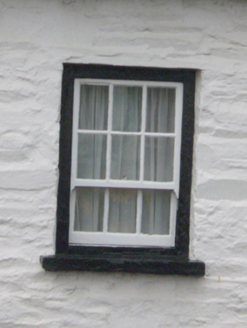Survey Data
Reg No
40807023
Rating
Regional
Categories of Special Interest
Architectural
Original Use
House
In Use As
House
Date
1800 - 1840
Coordinates
201849, 437187
Date Recorded
18/11/2010
Date Updated
--/--/--
Description
Attached mid-terrace six-bay single-storey vernacular house, built c. 1820 and altered c. 1880. Single-storey addition to the rear (west). Originally two (or possibly three) adjoining houses late combined to form a single property. One of a terrace of three with the buildings to either end (north and south). Pitched natural slate roof with rendered verges to the gable ends, and with three smooth rendered chimneystacks with flat copings over. Painted limewashed rubble stone walls over smooth painted plinth course. Square-headed window openings with painted stone sills and six-over-six pane timber sliding sash windows. Two square-headed doorways with battened timber doors. Set back from road with laneway and garden to the east. Located to the south of the centre of Dunfanaghy. Rubble stone boundary wall to road-frontage to the east.
Appraisal
This charming vernacular house retains its early form and character despite some recent alterations. It was originally two or possibly three adjoining dwellings that were later amalgamated to form a single property. Its visual appeal and integrity are enhanced by the retention of salient fabric such as the timber sliding sash windows. It is the best surviving example along a terrace of three buildings with the structures adjoining to either end (north and south). It originally formed part of a larger terrace that was mainly in existence by 1836 (Ordnance Survey first edition six-inch map); at least thirteen buildings formed this terrace c. 1904 (Ordnance Survey twenty-five inch map). The house is an attractive feature along the streetscape to the south of the centre of Dunfanaghy, and is an addition to the built heritage of the local area. Its small-scale follows the traditional hierarchy of scale of buildings within market towns with smaller, more domestic, dwellings lining secondary routes away from the centre.





